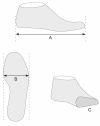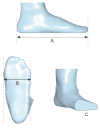Evaluation of the accuracy of shoe fitting in older people using three-dimensional foot scanning
- PMID: 24456656
- PMCID: PMC3903039
- DOI: 10.1186/1757-1146-7-3
Evaluation of the accuracy of shoe fitting in older people using three-dimensional foot scanning
Abstract
Background: Ill-fitting footwear is a common problem in older people. The objective of this study was to determine the accuracy of shoe fitting in older people by comparing the dimensions of allocated shoes to foot dimensions obtained with a three-dimensional (3D) scanner.
Methods: The shoe sizes of 56 older people were determined with the Brannock device®, and weightbearing foot scans were obtained with the FotoScan 3D scanner (Precision 3D Ltd, Weston-super-mare, UK). Participants were provided with a pair of shoes (Dr Comfort®, Vista, CA, USA), available in three width fittings (medium, wide and extra wide). The dimensions (length, ball width and ball girth) of the allocated shoes were documented according to the last measurements provided by the manufacturer. Mean differences between last dimensions and foot dimensions obtained with the 3D scanner were calculated to provide an indication of shoe fitting accuracy. Participants were also asked to report their perception of shoe fit and comfort, using 100 mm visual analogue scales (VAS).
Results: Shoe size ranged from US size 7 to 14 for men and 5.5 to 11 for women. The allocated shoes were significantly longer than the foot (mean 23.6 mm, 95% confidence interval [CI] 22.1 to 25.2; t55 = 30.3, p < 0.001), however there were no significant differences in relation to ball width (mean 1.4 mm, 95% CI -0.1 to 2.9 mm; t55 = 1.9, p = 0.066) or ball girth (mean -0.7 mm, 95% CI -6.1 to 4.8 mm; t55 = -0.2, p = 0.810). Participants reported favourable perceptions of shoe fit (mean VAS = 90.7 mm, 95% CI 88.4 to 93.1 mm) and comfort (mean VAS = 88.4 mm, 95% CI 85.0 to 91.8 mm).
Conclusion: Shoe size selection using the Brannock device® resulted in the allocation of shoes with last dimensions that were well matched to the dimensions of the foot. Participants also considered the shoes to be well fitted and comfortable. Older people with disabling foot pain can therefore be dispensed with appropriately-fitted shoes using this technique, provided that the style and materials used are suitable and extra width fittings are available.
Figures






Similar articles
-
Reproducibility of foot dimensions measured from 3-dimensional foot scans in children and adolescents with Down syndrome.J Foot Ankle Res. 2020 Jun 4;13(1):31. doi: 10.1186/s13047-020-00403-1. J Foot Ankle Res. 2020. PMID: 32498702 Free PMC article.
-
Children's school footwear: The impact of fit on foot function, comfort and jump performance in children aged 8 to 12 years.Gait Posture. 2021 Jun;87:87-94. doi: 10.1016/j.gaitpost.2021.04.025. Epub 2021 Apr 18. Gait Posture. 2021. PMID: 33895636
-
Shoe design for older adults: Evidence from a systematic review on the elements of optimal footwear.Maturitas. 2019 Sep;127:64-81. doi: 10.1016/j.maturitas.2019.06.002. Epub 2019 Jun 6. Maturitas. 2019. PMID: 31351522
-
Older people and ill fitting shoes.Postgrad Med J. 2002 Jun;78(920):344-6. doi: 10.1136/pmj.78.920.344. Postgrad Med J. 2002. PMID: 12151688 Free PMC article.
-
A fitting problem: Standardising shoe fit standards to reduce related diabetic foot ulcers.Diabetes Res Clin Pract. 2019 Aug;154:66-74. doi: 10.1016/j.diabres.2019.05.017. Epub 2019 May 22. Diabetes Res Clin Pract. 2019. PMID: 31128134 Review.
Cited by
-
Effects of supportive and minimalist footwear on standing balance and walking stability in older women.J Foot Ankle Res. 2023 Jun 19;16(1):38. doi: 10.1186/s13047-023-00634-y. J Foot Ankle Res. 2023. PMID: 37331962 Free PMC article.
-
Comparison of the responsiveness of the foot health status questionnaire and the Manchester foot pain and disability index in older people.Health Qual Life Outcomes. 2014 Oct 25;12:158. doi: 10.1186/s12955-014-0158-4. Health Qual Life Outcomes. 2014. PMID: 25344024 Free PMC article.
-
Foot Measurements From Three-Dimensional Scans: Elinvision 3DST Reliability.J Foot Ankle Res. 2025 Sep;18(3):e70070. doi: 10.1002/jfa2.70070. J Foot Ankle Res. 2025. PMID: 40737191 Free PMC article.
-
Foot Orthosis and Sensorized House Slipper by 3D Printing.Materials (Basel). 2022 Jun 8;15(12):4064. doi: 10.3390/ma15124064. Materials (Basel). 2022. PMID: 35744123 Free PMC article.
-
Reproducibility of foot dimensions measured from 3-dimensional foot scans in children and adolescents with Down syndrome.J Foot Ankle Res. 2020 Jun 4;13(1):31. doi: 10.1186/s13047-020-00403-1. J Foot Ankle Res. 2020. PMID: 32498702 Free PMC article.
References
-
- Rossi WA. Why shoes make “normal” gait impossible. Podiatry Management. 1999. pp. 50–61.
-
- Nixon BP, Armstrong DG, Wendell C, Vazquez JR, Rabinovich Z. Do US veterans wear appropriately sized shoes? the veteran affairs shoe size selection study. J Am Podiatr Med Assoc. 2006;96:290–292. - PubMed
LinkOut - more resources
Full Text Sources
Other Literature Sources
Research Materials

